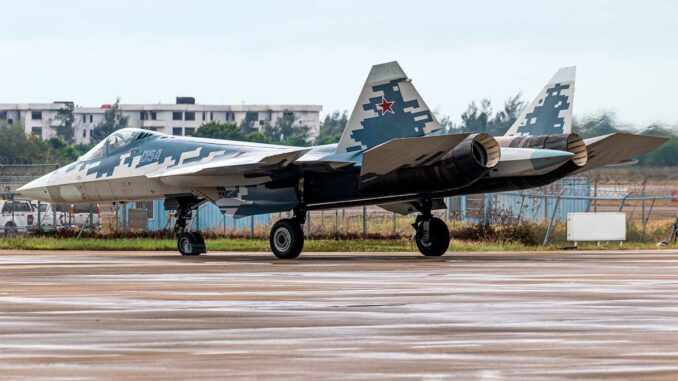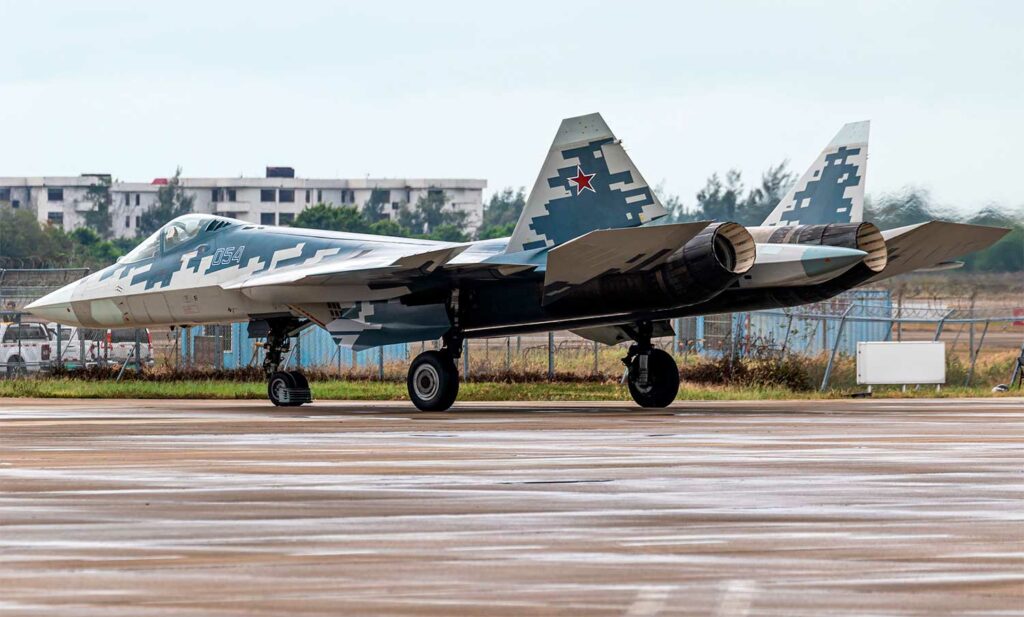
The R-37M air-to-air missile integrated into the Su-57 Felon has a range of 200 km and enhances the long-range interception capabilities of Russian aviation.
Summary
The Sukhoi Su-57 Felon is the first Russian 5th generation fighter to integrate the R-37M / Izdeliye 810 long-range air-to-air missile. Capable of engaging targets up to 200 km away, this missile is a significant improvement to Russian air defense. Its compatibility with the Su-57’s internal bays preserves the aircraft’s stealth. The system combines inertial guidance for the initial phase and active AESA guidance for the terminal phase, ensuring accuracy and resistance to jamming. The foldable strakes ensure its integration into the fighter’s stealth airframe. Already proven on the MiG-31BM as an interceptor missile, the R-37M adapts this performance to high-intensity combat by giving the Su-57 the ability to engage fast, high-altitude targets beyond visual range. It positions the Felon as a credible adversary to Western fighters, notably the F-35 and F-22, in the field of long-range combat.
A missile designed for long-range interception
The R-37M, known by the code Izdeliye 810, is an evolution of the R-33 designed for the MiG-31. Its initial mission was to intercept fast, heavy targets such as strategic bombers or surveillance aircraft.
The missile weighs approximately 510 kg, is 4.06 m long, and uses a dual-pulse rocket motor, offering a speed greater than Mach 6. This energy allows it to intercept targets at 200 km in optimal conditions, particularly when fired at high altitude and high speed.
In the context of the Su-57, the R-37M gives the fighter jet an extended range to engage enemy aircraft before they reach the effective firing range of their own missiles. This represents a crucial tactical advantage against command and surveillance platforms such as the E-3 AWACS, maritime patrol aircraft, or bombers.
Internal integration with the Su-57 and preservation of stealth
One of the major innovations of the Izdeliye 810 is its compatibility with the internal bays of the Su-57. Unlike the MiG-31, which carries its missiles under its wings, the Felon can carry the R-37M in its fuselage without compromising its radar signature.
To achieve this, the missile has been equipped with foldable strakes, which deploy after launch to ensure aerodynamic stability. This design allows the Su-57’s stealth potential to be fully exploited by reducing the radar cross-section (RCS) and thus the probability of detection by enemy radars.
This internal integration means that the Su-57 can approach closer to contested areas without revealing its presence prematurely, while being ready to launch a long-range missile in the event of a threat. This improves the aircraft’s survivability and the pilot’s freedom of maneuver in contested air warfare environments.
Guidance system: inertial and active AESA radar
The R-37M uses inertial navigation for the initial phase of flight, allowing it to follow a predefined trajectory to the target without relying on external signals. This capability is valuable in environments saturated with electronic jamming.
As it approaches the target, the missile activates its integrated active electronically scanned array (AESA) radar, which provides increased accuracy and better resistance to electronic countermeasures. The use of AESA also allows the missile to quickly adapt to the target’s evasive maneuvers and maintain lock-on in the presence of decoys.
The Su-57 pilot benefits from the data link between the aircraft and the missile, allowing him to update the trajectory in real time during the projectile’s flight. This combination of technologies significantly improves the probability of interception, especially against fast and maneuverable targets.
Tactical utility for the Su-57 and its pilot
The combination of the Su-57 and the R-37M offers the pilot a beyond visual range (BVR) engagement capability unmatched in the Russian Air Force.
The Su-57, thanks to its own sensors, including the N036 Belka radar and its side and infrared sensors, can detect targets at long range and engage them before entering the threat zone of enemy missiles.
This makes it possible to neutralize strategic targets such as airborne command aircraft, in-flight refueling aircraft, and surveillance drones, which play a critical role in modern operations.
The pilot gains tactical flexibility, as they can fire and retreat quickly or pursue secondary targets without risking close-range confrontation. In the context of modern combat, where information superiority is often decisive, this capability directly contributes to reducing the cohesion of enemy forces.

Comparison with Western weapons
The R-37M differs from Western long-range air-to-air missiles such as the AIM-120D AMRAAM and the European Meteor.
The AIM-120D, currently standard issue for the US Air Force and many NATO allies, has a stated range of approximately 160 km, but its speed is lower than that of the R-37M and it is less optimized for intercepting high-altitude, high-speed aircraft.
The Meteor, produced by MBDA, is renowned for its ramjet propulsion and high terminal energy, but its operational range is between 120 and 150 km, which is still less than that of the Russian missile.
However, these Western missiles are better integrated into collaborative networks such as Link 16 and benefit from fighter radars such as the F-35. This highlights that the pure performance of the missile is only one factor: mission success also depends on the quality of the sensors and command networks.
Limitations and operational assessment
While the R-37M offers a theoretical advantage, its actual effectiveness depends on several factors.
First, the maximum range of 200 km is achieved under optimal conditions—launch at high altitude and speed, against a target with limited maneuverability. Against an agile fighter flying at low altitude, the practical range can be significantly reduced.
Second, the missile remains vulnerable to advanced electronic countermeasures, even though AESA radar improves its resistance. The probability of destruction against stealth targets remains uncertain, as acquiring such targets at long range remains a challenge for current sensors.
Finally, its track record in actual missions remains limited. Although the R-37M has been used by MiG-31BMs in the Ukrainian conflict, most of the shots were aimed at support aircraft or drones, not modern maneuvering fighters. This leaves open the question of its performance against networked stealth aircraft.
A balancing factor in the technological competition
The integration of the R-37M into the Su-57 illustrates Moscow’s priority for long-range air deterrence. By equipping its fifth-generation fighter with a missile designed to intercept critical targets well beyond the front line, Russia is strengthening its ability to challenge allied air superiority.
This is forcing Western forces to rethink their tactics, notably by strengthening the defense of their support aircraft and adapting the flight paths of their reconnaissance and refueling aircraft.
The rise of systems such as the R-37M and their future equivalents shows that the air-to-air arms race is shifting toward a combination of range, speed, and network integration, as well as platform stealth.
An evolution that redefines the priorities of air warfare
The Su-57 – R-37M combination embodies an offensive approach to air superiority: neutralizing critical nodes in the enemy’s structure from a distance rather than directly confronting opposing fighters.
This philosophy is consistent with Russian doctrine, which seeks to limit the Western advantage in command and in-flight refueling.
It also foreshadows a future where success will no longer depend solely on the air platform, but on the entire ecosystem combining sensors, long-range missiles, drones, and electronic warfare systems.
By becoming the carrier of the R-37M, the Su-57 marks a milestone in this logic and forces other major air powers to take the threat of very long-range strikes into account in their planning.
War Wings Daily is an independant magazine.